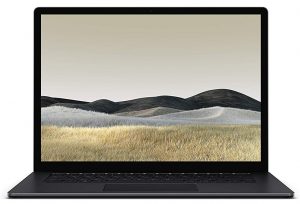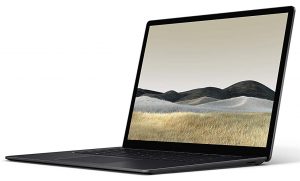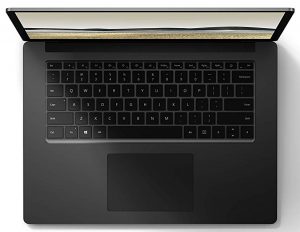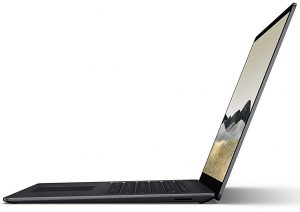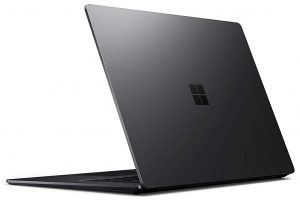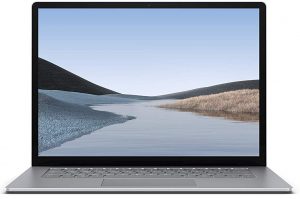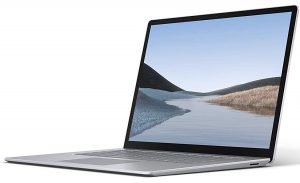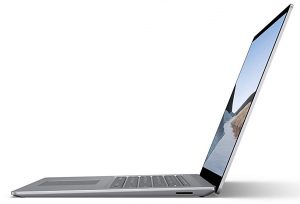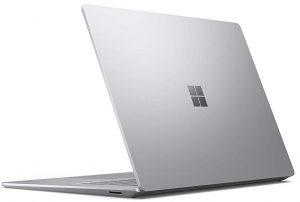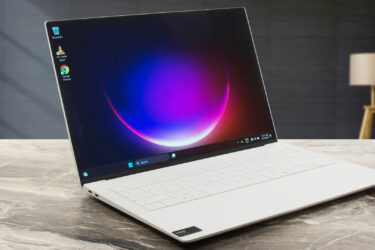Microsoft Surface Laptop 3 (15) review – an excellent 3:2 display, custom AMD processors and extremely tight form factor
 We were finally able to snatch a retail unit of the Microsoft Surface Laptop 3 (15). For those who know little about it, Microsoft is trying to implement the Apple technique and sells their own, branded laptop computers. Only a tiny part of the full range of Microsoft products, the Surface Laptop 3 (15), is aimed at students, office workers, and people who need a device for their daily productivity tasks like word processing, Office 365-related work or just browsing the Web.
We were finally able to snatch a retail unit of the Microsoft Surface Laptop 3 (15). For those who know little about it, Microsoft is trying to implement the Apple technique and sells their own, branded laptop computers. Only a tiny part of the full range of Microsoft products, the Surface Laptop 3 (15), is aimed at students, office workers, and people who need a device for their daily productivity tasks like word processing, Office 365-related work or just browsing the Web.
Inside the impressive package, we can find a 3:2 15-inch display with a resolution of 2496 x 1664p, a 10-point multi-touch sensor, and a Surface Pen support. Paired with that we have a sleek all-aluminum body, with a compact NumberPad-less keyboard and a ton of unused space on the base.
Some people don’t really fancy the narrow aspect ratio, because most of the video content out there is going towards wider ratios – 16:9, and even 18:9 and 21:9 on rare occasions. Nevertheless, the 3:2 one has its own advantages, especially, if you are a developer or you are mostly browsing the Web. Additionally, the device comes in a “regular” and “business” variants, where the former comes with custom AMD Ryzen processors, while the latter is equipped with the more popular, but also more expensive Intel Ice Lake CPUs.
You can check the prices and configurations in our Specs System: https://laptopmedia.com/series/microsoft-surface-laptop-3-15-0/
Contents
Specs Sheet
- Display
- 15”, (2496 x 1664), IPS
- HDD/SSD
- up to 1000GB SSD
- RAM
- up to 32GB
- OS
- Windows 10 Home, Windows 10 Pro, Windows OS
- Dimensions
- 339.5 x 244 x 14.7 mm (13.37" x 9.61" x 0.58")
- Weight
- 1.54 kg (3.4 lbs)
- Ports and connectivity
- 1x USB Type-C
- 1x USB Type-A
- Wi-Fi
- 802.11ax
- Bluetooth
- 5.0
- Audio jack
- 3.5 mm combo
- Surface Connect Port
- Features
- Fingerprint reader
- Web camera
- HD
- Backlit keyboard
- optional
- Microphone
- Dual Far-Field Studio
- Speakers
- Omnisonic Speakers, Dolby Atmos
- Optical drive
All Microsoft Surface Laptop 3 (15.0″) configurations
What’s in the box?
As a typical premium notebook, you will receive it in a good quality branded box. Inside, you’ll find the laptop itself, and two compartments – one containing the paper manuals, and one holding the 65W charger.
Design and construction
Man, this device is built nicely. It is extremely simple, weighs only 1.542 kg (pretty specific info from Microsoft by the way), and has a profile of 14.7mm, making it comfortably one of the most portable notebooks on the market. Additionally, it reacts to stress without breaking a sweat. If you remember, the 13.5″ version of the Surface Laptop 3 offered an aluminum base, as well as an Alcantara one. However, this iteration fo the device comes only in aluminum.
Expectedly, the lid can be opened with a single hand and the hinges seem very balanced throughout their entire travel. Apart from the weird 3:2 aspect ratio, you get a glass cover with bezels that look a bit thick in 2020.
Furthermore, you have a NumberPad-less keyboard with slightly smaller keycaps than what we’re used to. In terms of experience, it feels solid and homogenous all around, and while the feedback is clicky-enough, we think that the travel is short. Despite that, it is still a far more comfortable unit than the Butterfly nonsense of Apple.
And while the touchpad has a glass surface, amazing gliding and tracking experience, and obviously – Windows Precision drivers, we feel that it is too small, compared to some of its direct competitors, and moreover – the free space around the palm-rest area.
So, you turn the laptop upside down, and you see… nothing? Well, that’s because the speakers are hidden beneath the keyboard, and actually, here, the keyboard acts as a grill.
Ports
Sadly, the premium devices in 2020 come with a very limited set of ports. Here, we have a single USB Type-C port, a USB Type-A port, and a headphone jack. This is all located on the left, while on the right, you can find the proprietary magnetic charging plug.
Display quality
Microsoft Surface Laptop 3 (15) is equipped with an IPS screen, model number Sharp LQP1JXP1 SHP14B1. Its diagonal is 15.0″ (38.1 cm), and the resolution – 2496 x 1664. Additionally, the screen ratio is 3:2, the pixel density – 200 ppi, their pitch – 0.127 x 0.127 mm. The screen can be considered Retina when viewed from at least 40 cm (from this distance, the average human eye can’t see the individual pixels).

Its viewing angles are comfortable. We have provided images at 45 degrees to evaluate quality.

The maximum measured brightness is 410 nits (cd/m2) in the middle of the screen and 393 nits (cd/m2) average across the surface with a maximum deviation of only 3%. The Correlated Color Temperature on a white screen and at maximum brightness is 6770K (average) – slightly colder than the 6500K optimum for sRGB.
In the illustration below you can see how the display performs from uniformity perspective. The illustration below shows how matters are for operational brightness levels (approximately 140 nits) – in this particular case at 61% Brightness (White level = 143 cd/m2, Black level = 0.11 cd/m2).
Values of dE2000 over 4.0 should not occur, and this parameter is one of the first you should check if you intend to use the laptop for color-sensitive work (a maximum tolerance of 2.0 ). The contrast ratio is very good – 1250:1 (1130:1 after profiling).
To make sure we are on the same page, we would like to give you a little introduction to the sRGB color gamut and the Adobe RGB. To start, there’s the CIE 1976 Uniform Chromaticity Diagram that represents the visible specter of colors by the human eye, giving you a better perception of the color gamut coverage and the color accuracy.
Inside the black triangle, you will see the standard color gamut (sRGB) that is being used by millions of people in HDTV and on the web. As for the Adobe RGB, this is used in professional cameras, monitors, etc for printing. Basically, colors inside the black triangle are used by everyone and this is the essential part of the color quality and color accuracy of a mainstream notebook.
Still, we’ve included other color spaces like the famous DCI-P3 standard used by movie studios, as well as the digital UHD Rec.2020 standard. Rec.2020, however, is still a thing of the future and it’s difficult for today’s displays to cover that well. We’ve also included the so-called Michael Pointer gamut, or Pointer’s gamut, which represents the colors that naturally occur around us every day.
The yellow dotted line shows Microsoft Surface Laptop 3 (15)’s color gamut coverage.
Its display covers 96% of the sRGB/ITU-R BT.709 (web/HDTV standard) in CIE1976, which provides a vibrant and punchy image.

Our “Design and Gaming” profile delivers optimal color temperature (6500K) at 140 cd/m2 luminance and sRGB gamma mode.
We tested the accuracy of the display with 24 commonly used colors like light and dark human skin, blue sky, green grass, orange, etc. You can check out the results at factory condition and also, with the “Design and Gaming” profile.
Below you can compare the scores of Microsoft Surface Laptop 3 (15) with the default settings (left), and with the “Gaming and Web design” profile (right).


The left side of the image represents the display with stock settings, while the right one is with the “Gaming and Web Design” profile activated. On the horizontal axis, you will find the grayscale and on the vertical axis – the luminance of the display. On the two graphs below you can easily check for yourself how your display handles the darkest nuances but keep in mind that this also depends on the settings of your current display, the calibration, the viewing angle, and the surrounding light conditions.

Response time (Gaming capabilities)
We test the reaction time of the pixels with the usual “black-to-white” and “white-to-black” method from 10% to 90% and vice versa.
We recorded Fall Time + Rise Time = 30 ms

Health impact – PWM / Blue Light
PWM (Screen flickering)
Pulse-width modulation (PWM) is an easy way to control monitor brightness. When you lower the brightness, the light intensity of the backlight is not lowered, but instead turned off and on by the electronics with a frequency indistinguishable to the human eye. In these light impulses, the light/no-light time ratio varies, while brightness remains unchanged, which is harmful to your eyes. You can read more about that in our dedicated article on PWM.
Microsoft Surface Laptop 3 (15)’s display doesn’t use PWM for brightness adjustment. This makes it comfortable for long working periods, without being harmful to your eyes in this aspect.

Blue light emissions
Installing our Health-Guard profile not only eliminates PWM but also reduces the harmful Blue Light emissions while keeping the colors of the screen perceptually accurate. If you’re not familiar with the Blue light, the TL;DR version is – emissions that negatively affect your eyes, skin, and your whole body. You can find more information about that in our dedicated article on Blue Light.
Conclusions
Undoubtedly, Microsoft Surface Laptop 3 (15)’s strongest point is its touchscreen display. With its high-resolution IPS panel, comfortable viewing angles, great contrast ratio, and 96% sRGB coverage, viewing it is a real candy to the eye. Moreover, it doesn’t flicker and it can be used for color-sensitive work when our Gaming and Web design profile is present.
Buy our profiles
Since our profiles are tailored for each individual display model, this article and its respective profile package are meant for Microsoft Surface Laptop 3 (15) configurations with 15.0″ Sharp LQP1JKP1 SHP14B4 (2496×1664) IPS.
*Should you have problems with downloading the purchased file, try using a different browser to open the link you’ll receive via e-mail. If the download target is a .php file instead of an archive, change the file extension to .zip or contact us at [email protected].
Read more about the profiles HERE.
In addition to receiving efficient and health-friendly profiles, by buying LaptopMedia's products you also support the development of our labs, where we test devices in order to produce the most objective reviews possible.

Office Work
Office Work should be used mostly by users who spend most of the time looking at pieces of text, tables or just surfing. This profile aims to deliver better distinctness and clarity by keeping a flat gamma curve (2.20), native color temperature and perceptually accurate colors.

Design and Gaming
This profile is aimed at designers who work with colors professionally, and for games and movies as well. Design and Gaming takes display panels to their limits, making them as accurate as possible in the sRGB IEC61966-2-1 standard for Web and HDTV, at white point D65.

Health-Guard
Health-Guard eliminates the harmful Pulse-Width Modulation (PWM) and reduces the negative Blue Light which affects our eyes and body. Since it’s custom tailored for every panel, it manages to keep the colors perceptually accurate. Health-Guard simulates paper so the pressure on the eyes is greatly reduced.
Get all 3 profiles with 33% discount
Sound
Microsoft Surface Laptop 3 (15)’s speakers produce a very good sound for a Windows machine. Its maximum volume is high and the quality is on point.

Drivers
All of the drivers and utilities for the Surface Laptop 3 with Intel CPUs can be found here: https://www.microsoft.com/download/details.aspx?id=100429
And these for the Surface Laptop 3 with AMD processors can be downloaded from here: https://www.microsoft.com/en-us/download/details.aspx?id=100428
Battery
Now, we conduct the battery tests with Windows Better performance setting turned on, screen brightness adjusted to 120 nits, and all other programs turned off except for the one we are testing the notebook with. This device has a 45.8 Wh battery, which looks kind of disappointing. However, we got well over 10 hours of Web browsing and watching videos on a loop set us back at 8 hours.
In order to simulate real-life conditions, we used our own script for automatic web browsing through over 70 websites.
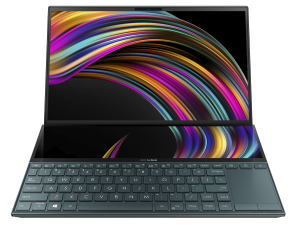
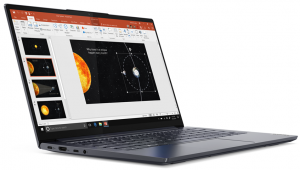
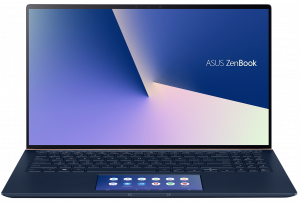
For every test like this, we use the same video in HD.



CPU options
In terms of processors, you have two options from each AMD and Intel. The former includes the specially designed Ryzen 5 3580U and the Ryzen 7 3780U. However, the so-called “Business” version of the notebook comes with the Intel Core i5-1035G7 and the Core i7-1065G7 Ice Lake CPUs.
Results are from the Cinebench 20 CPU test (the higher the score, the better)
Results are from our Photoshop benchmark test (the lower the score, the better)
Microsoft Surface Laptop 3 (15.0") CPU variants
Here you can see an approximate comparison between the CPUs that can be found in the Microsoft Surface Laptop 3 (15.0") models on the market. This way you can decide for yourself which Microsoft Surface Laptop 3 (15.0") model is the best bang for your buck.
Note: The chart shows the cheapest different CPU configurations so you should check what the other specifications of these laptops are by clicking on the laptop’s name / CPU.
Results are from the Cinebench 20 CPU test (the higher the score, the better)
Results are from our Photoshop benchmark test (the lower the score, the better)
GPU options
Respectively, the AMD options feature the Radeon Vega 9 and the RX Vega 11 integrated solution, whereas the Intel CPUs offer the Iris Plus Graphics G7 with both the processors.
Results are from the 3DMark: Fire Strike (Graphics) benchmark (higher the score, the better)
Results are from the Unigine Superposition benchmark (higher the score, the better)
Microsoft Surface Laptop 3 (15.0") GPU variants
Here you can see an approximate comparison between the GPUs that can be found in the Microsoft Surface Laptop 3 (15.0") models on the market. This way you can decide for yourself which Microsoft Surface Laptop 3 (15.0") model is the best bang for your buck.
Note: The chart shows the cheapest different GPU configurations so you should check what the other specifications of these laptops are by clicking on the laptop’s name / GPU.
Results are from the 3DMark: Time Spy (Graphics) benchmark (higher the score, the better)
Results are from the 3DMark: Fire Strike (Graphics) benchmark (higher the score, the better)
Results are from the Unigine Superposition benchmark (higher the score, the better)
Gaming tests

| DOTA 2 | HD 1080p, Low (Check settings) | HD 1080p, Normal (Check settings) | HD 1080p, High (Check settings) |
|---|---|---|---|
| Average FPS | 94 fps | 55 fps | 30 fps |
Temperatures and comfort
Max CPU load
In this test we use 100% on the CPU cores, monitoring their frequencies and chip temperature. The first column shows a computer’s reaction to a short load (2-10 seconds), the second column simulates a serious task (between 15 and 30 seconds), and the third column is a good indicator of how good the laptop is for long loads such as video rendering.
Average core frequency (base frequency + X); CPU temp.
| AMD Ryzen 5 3580U (15W TDP) | 0:02 – 0:10 sec | 0:15 – 0:30 sec | 10:00 – 15:00 min |
|---|---|---|---|
| Microsoft Surface Laptop 3 (15) | 3.16 GHz (B+50%) @ 59°C | 3.15 GHz (B+50%) @ 66°C | 2.79 GHz (B+33%) @ 69°C |
If we concentrate on the numbers only, we can see a very, very cool processor, that delivers impressively high clock speeds, despite its 15W TDP.
Comfort during full load
Even under heavy load, the laptop remains rather quiet, while the temperature on the keyboard deck reaches around 40-41C.


Verdict
 Now, drawing a conclusion with this device is quite difficult. Although it feels extremely good using it, we just can’t forget its price tag. With that said, we must start the last part of this review with something disappointing. Our unit (and from what we saw on the Web, many others), had an issue. As soon as we apply a heavy load (for example with Cinebench R20), the laptop runs for a couple of seconds, and then it shuts itself off. Without any indications of what the error could be – no blue screen of death, no pop-up dialogue. Nothing. However, we found something interesting. Unlike many other laptops that come through our hands, the Surface Laptop 3 (15) has the Better Battery Life set as Recommended under the Power Mode menu. And, as soon as we switched from the Best Performance to this mode, all the issues were resolved.
Now, drawing a conclusion with this device is quite difficult. Although it feels extremely good using it, we just can’t forget its price tag. With that said, we must start the last part of this review with something disappointing. Our unit (and from what we saw on the Web, many others), had an issue. As soon as we apply a heavy load (for example with Cinebench R20), the laptop runs for a couple of seconds, and then it shuts itself off. Without any indications of what the error could be – no blue screen of death, no pop-up dialogue. Nothing. However, we found something interesting. Unlike many other laptops that come through our hands, the Surface Laptop 3 (15) has the Better Battery Life set as Recommended under the Power Mode menu. And, as soon as we switched from the Best Performance to this mode, all the issues were resolved.
No accidental shutdowns, screen turn-offs, or anything. Just like this never happened. What we think happened here, is that Microsoft found a quick solution to this problem, and never tried to actually resolve it. On the other side, we didn’t see a mindblowing difference in the performance of the notebook between the Better Battery Life mode and the Best Performance one.
Next, there is the 45.8Wh battery. Well, this looks pretty modest, doesn’t it? Especially if you compare it to the 100Wh battery of the 16-inch MacBook Pro. However, it comfortably lasts an entire workday away from the plug with its 10 hours and 40 minutes of Web browsing and 8 hours of video playback.
Sadly, instead of opposing Apple, Microsoft copied their limited I/O. Instead of giving you a couple of USB Type-C ports and calling it a day, the fellas from Redmont decided to give you a single USB Type-A port and a headphone jack. How generous of them… At least you can upgrade your storage with an M.2 NVMe drive, although Microsoft is clearly saying it is not user-removable, and also it has a weird size – 2230, in contrast to the more popular 2242 and 2280.
Undoubtedly, Microsoft Surface Laptop 3 (15)’s strongest point is its touchscreen display. With its high-resolution IPS panel (Sharp LQP1JXP1), comfortable viewing angles, great contrast ratio, and 96% sRGB coverage, viewing it is a real candy to the eye. Moreover, it doesn’t flicker and it can be used for color-sensitive work when our Gaming and Web design profile is present.
So guys, the Surface Laptop 3 (15) is exactly what Microsoft states it is – a laptop that will guide you with your Office 365 work, word processing, countless hours of Web browsing, and in our view, photo and light video editing. If you are genuinely unpretentious, you have no problem buying a separate dongle and money is not a problem for you, go for it, this device has some quality. Just remember the drill – keep the Power Mode setting down at “Better Battery Mode” and you shouldn’t have any problems.
Pros
- An all-aluminum chassis with great quality of build
- Covers 96% of sRGB and our Gaming and Web design profile helps it to an Average dE of 1.5 (Sharp LQP1JXP1)
- Good contrast ratio and comfortable viewing angles (Sharp LQP1JXP1)
- Doesn’t use PWM to adjust its brightness (Sharp LQP1JXP1)
- Nice-sounding speakers and 410 nits of maximum brightness
Cons
- Extremely modest I/O
- Poor upgradability
You can check the prices and configurations in our Specs System: https://laptopmedia.com/series/microsoft-surface-laptop-3-15-0/
